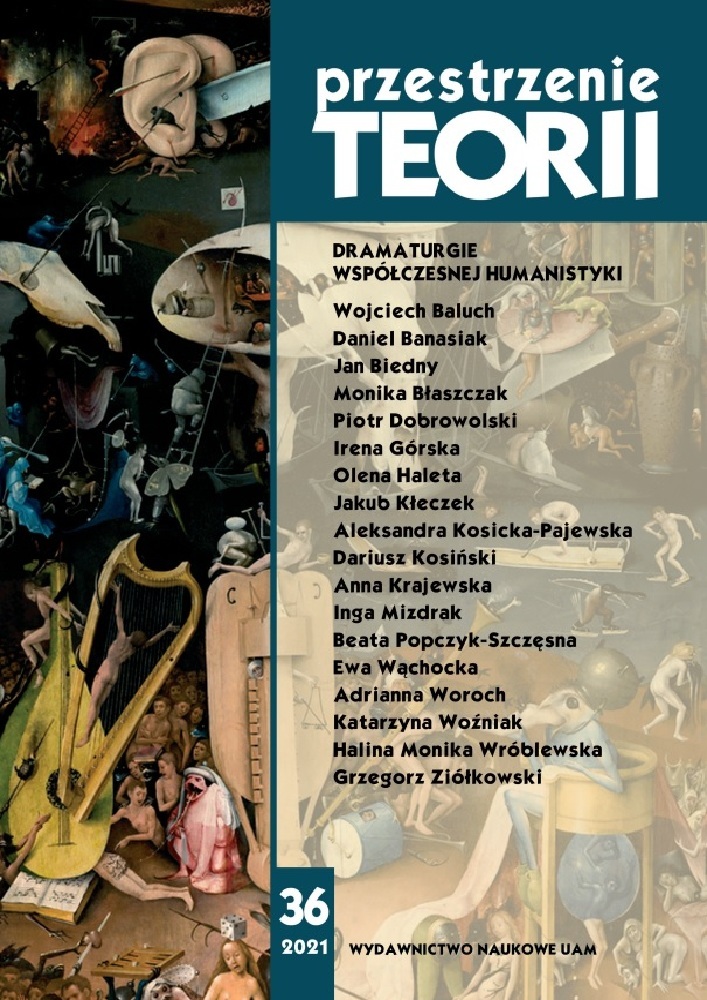Abstract
In her paper, Ewa Wąchocka examines the phenomenon of recent dramatic works becoming increasingly more ‘musical’ and the terminological shift it brought about, i.e. the inclusion of the term ‘musical dramaturgy’ in writing for the stage. The author argues that far from being limited to the sounds of speech and language in general, musicality also encompasses a variety of non-musical sounds, the unravelling of the play’s narrative and the psychological makeup of its characters; it also penetrates deeply into the structure of the text. In the analysis of plays by W. Murek, A. Grzegorzewska, and S. Bogacz, the author demonstrates how essential the inspirations sourced from musical culture are for recent dramatic works: the 20th-century experiments with music, the discovery of how potent sound expression can be, or the most technologically advanced methods of sound reproduction. By presenting the many and varied dramatic strategies, the author shows that contemporary playwrights not only use musicality to represent the sound landscape of the world but, first and foremost, to create the ontology of an internally conflicted world.
References
Berger K., Narracja i liryka, [w:] Interdisciplinary Studies in Musicology, red. J. Stęszewski, M. Jabłoński, Poznań 1993.
Bruns G.L., Disappeared: Heidegger and the Emancipation of Language: The Play of Negativity in Literature and Literary Theory, red. S. Budick, W. Iser, Columbia University Press, New York 1989.
Chęćka-Gotkowicz A., Persona (non) grata. Czy muzyka absolutna potrzebuje narratora?, „Aspekty Muzyki” 2013, t. 3.
Cone E.T., The Composer’s Voice, University of California Press, Berkeley 1974, s. 5.
Dahlhaus C., Estetyka muzyki, przeł. Z. Skowron, Warszawa 2014.
Davies S., The Expression of Emotion in Music, „Mind” 1980, nr 89.
Fischer-Lichte E., Estetyka performatywności, przeł. M. Borowski, M. Sugiera, Kraków 2008.
Grzegorzewska A., Za mało, „Dialog” 2017, nr 1.
Karasińska M., Muzyka i dramat. Razem czy osobno, [w:] eadem, Zapiski z teorii teatru, Poznań 2020.
Kawin B.F., Telling It Again and Again. Repetition in Literature and Film, Cornell University Press, Ithaca and London 1972.
Levonson J., Music as Narrative and Music as Drama, „Mind and Language” 2004, nr 19 (4).
Maus F.E., Music as Drama, [w:] Music and Meaning, red. J. Robinson, Cornell University Press, Ithaca and London 1997.
Murek W., Feinweinblein, „Dialog” 2015, nr 7–8.
Ovadija M., Dramaturgy of Sound in the Avant-garde and Postdramatic Theatre, Mcgill-Queen’s University Press, Montreal 2013.
Pawłowska M., Narracja a muzyka: o globalnym „efekcie narratologicznym” i jego konsekwencjach w myśli o muzyce, „Kultura Współczesna” 2014, nr 3.
Rudzka Z., Zimny bufet, Kraków 2012.
Ryzyko stymuluje uwagę. Rozmowa W. Malinowskiego z J. Ostaszewskim, „Notatnik Teatralny” 1999, nr 18–19.
Schafer R.M., I Have Never Seen a Sound, „Environmental and Architectural Phenomenology” 2006, vol. 17, no. 2.
Skowron Z., Estetyka sformułowana Witolda Lutosławskiego, [w:] Estetyka i styl twórczości Witolda Lutosławskiego, red. Z. Skowron, Kraków 2000.
Szymańska-Stułka K., Muzyka i scena. O muzycznej teatralności – Les espaces du sommeil Witolda Lutosławskiego, [w:] Gangliony pękają mi od niewyrażalnych myśli, red. M. Hasiuk, A. Winch, Warszawa 2019.
Tomaszewski M., Narracja dzieła muzycznego jawna i domyślna, poufna i tajemna, „Polski Rocznik Muzykologiczny” 2017, XV, s. 201.
License
Authors
Authors of texts accepted for publication in Przestrzenie Teorii are required to complete, sign and return to the editor's office the Agreement for granting a royalty-free license to works with a commitment to grant a CC sub-license.
Under the agreement, the authors of texts published in Przestrzenie Teorii grant the Adam Mickiewicz University in Poznań a non-exclusive, royalty-free license and authorize the use of Attribution-NonCommercial-NoDerivatives 4.0 International (CC BY-NC-ND 4.0) Creative Commons sub-license.
The authors retain the right to continue the free disposal of the work.
Users
Interested Internet users are entitled to use works published in Przestrzenie Teorii since 2015, for non-commercial purposes only, under the following conditions:
- attribution - obligation to provide, together with the distributed work, information about the authorship, title, source (link to the original work, DOI) and the license itself.
- no derivatives - the work must be preserved in its original form, without the author's consent it is not possible to distribute the modified work, such as translations, publications, etc.
Copyrights are reserved for all texts published before 2015.
Miscellaneous
Adam Mickiewicz University in Poznań retains the right to magazines as a whole (layout, graphic form, title, cover design, logo etc.).

